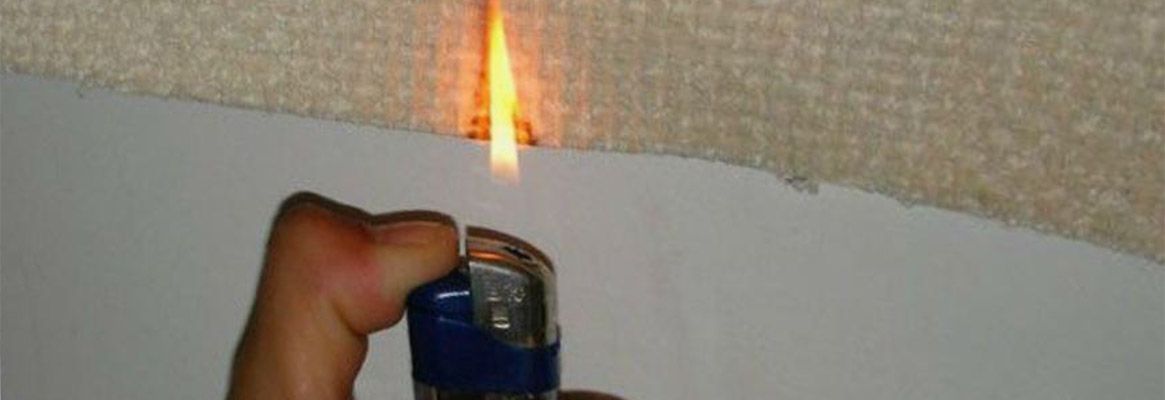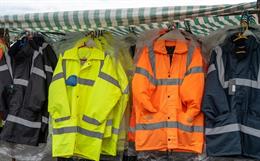Introduction
Nonwovens are finding more and more applications requiring flameretardancy in areas that were once the sole domain of woven textiles;Nonwoven products are mainly manufactured using synthetic fibers such aspolyolefin, polyester or nylon that represent highly flammable products.Polypropylene, in particular, burns very rapidly with a relatively low amountof smoke and without leaving a char residue because of its wholly aliphatichydrocarbon structure. Its self ignition temperature is around 570 C and itpresents a rapid decomposition rate compared with wood and other cellulosicmaterials.
The use of nonwovens manufactured with synthetic fibers can thus lead to anincreased fire risk in many cases. This has to be taken into account even morenowadays since there is a trend to replace high cost materials by lower costmaterials, for example polypropylene.
Flameretardancy of nonwovens can be achieved in two ways: additive(mechanically blending the FR chemistry with the polymer prior to extrusion)and topical (coating the fiber or fabric with the FR chemistry). Additive typesare useful with thermoplastics, while topical treatments can be used withthermoplastics, thermosets and natural fibers.
What are Flame Retardants and how do they Work?
There are several stages in the combustion process: heating, decomposition,ignition, flame spread and smoke generation. The combustion leads to theproduction of heat that is fed back and pyrolyzes the polymer, produces morefuel, and keeps the combustion process going. Flame retardants are chemicalsthat interfere in one or several of the steps in the combustion process. Thisis done in four distinct modes of action:
Aflame-retardant additive for nonwovens must meet the followingrequirements:
- The product must not adversely affect the natural color or coloration of the fiber.
- It must be non-smoking during fiber production.
- It must have no adverse effects on short- and long-term fiber properties.
- It must have no adverse effect on ultraviolet (UV) durability.
PhysicalAction
There are several ways in which the combustion process can be retarded byphysical action:
2. By cooling. The
degradation reactions of the additive can play a part in the energy balance
of combustion. The additive can degrade endothermally, which cools down
the substrate to a temperature below that required for sustaining the
combustion process.
3. By dilution. The incorporation of inert substances (e.g. fillers such as talc or chalk) and additives that produce inert gases on decomposition dilutes the fuel in the solid and gaseous phases so that the lower ignition limit of the gas mixture is not exceeded.
Chemical Action
The most significant chemical reactions interfering with the combustion process
take place in the condensed and gas phases:
1. Reaction in condensed phase. Here two types of reaction can take place. Firstly, breakdown of the polymer can be accelerated by the flame retardant causing a pronounced flow of the polymer and, hence, its withdrawal from the sphere of influence of the flame, which breaks away. Secondly, the flame retardant can cause a layer of carbon (charring), a ceramic-like structure and/or a glass to be formed on the polymer surface.
2. Reaction in gas phase. The radical mechanism of the combustion process that takes place in the gas phase is interrupted by the flame retardant or its degradation products.
The fire retardant additive systems may be used alone or in association with other systems in polymeric materials to obtain a synergistic effect, i.e. the protective effect is higher than is assumed from the addition of the separate effects of each system.
Different Approaches for Flame Retardant Nonwovens
Most fibers are highly combustible (except high performance fibers) and the
flammability of derived fabrics largely depends on the construction and density
of the fabric. Several approaches can be used to enhance the fire behavior of
fiber based fabrics used either alone or in blends with other fibers:
- Coatings and/or finishing treatments may be applied to shield fabrics from heat sources and prevent volatilization of flammable materials. These may take the form of simple protective coatings or, more commonly, the treatment of fabrics with inorganic salts that melt and form a glassy coating when exposed to ignition sources.
- Thermally unstable chemicals,
usually inorganic carbonates or hydrates, are incorporated in the material,
often as a back-coating so as to preserve the surface characteristics of the carpet
or fabric.
- Materials that are capable of dissipating significant amounts of heat are layered with the fabric or otherwise incorporated in a composite structure. These may be as simple as metal foils or other heat conductors or as complicated as a variety of phase-change materials that absorb large quantities of heat as they decompose or volatilize. If sufficient heat is removed from the point of exposure, the conditions for ignition are not reached.
- Char-promoting chemical treatments that may be fiber-reactive or un-reactive to yield launderable or non-durable flame retardancy, respectively.
- Chemicals capable of releasing free radical trapping agents, frequently organ bromine or organ chlorine compounds, may be incorporated into the fabric.
- In the particular case of synthetic fibers (approaches listed above are valid for both natural and synthetic fibers), the direct incorporation of additives (micro fillers and/or nanoparticles) or the chemical grafting/copolymerization of specific groups.
Flame
Retardant Fibers for Nonwovens
To make flame retarded fibers, several approaches can be considered:
- the incorporation of FR additive(s) in the polymer melt or in the solution prior to extrusion,
- the copolymerization or the grafting of FR molecules to the main polymeric chain, and
- The use of semi-durable or durable finishing. The only candidates for applying the first two approaches are synthetic fibers.
Synthetic fibers are numerous and all of them require flame retardancy, appropriate to their chemical formulation. We will then focus on the most established and used fibers. They include polylactic acid (PLA), polyester, polyamide and polypropylene. All these fibers are used for making nonwovens.
The multifilaments were knitted and the flammability studied using cone calorimetry at an external heat flux of 35 kW/m. Depending on the clay loading, the peak value of RHR is decreased by up to 38 % demonstrating the improved fire performance of these PLA fibers. Formation of char is observed in the case of the nanocomposites suggesting a mechanism of condensed-phase.
Polyester fibers are the main synthetic fibers used in the industrial manufacturing sector and can be found in several areas of application. As polyester fibers are easily flammable, flame retardancy is a significant issue. Polypropylene (PP) is presently one of the fastest growing fibers for technical end-uses where high tensile strength coupled with low cost are essential features.
An
acceptable flame retardant for polypropylene, especially fiber-forming grades,
should have
- a thermal stability up to the normal PP processing temperature (< 260 C),
- a good compatibility with PP and no migration of the additives,
- flame retardancy properties when present in the fiber and
- Efficiency at a relatively low level (typically less than 10 wt. %) to minimize its effect on fiber/textile properties as well as cost.
Applications of Flame Retardant Nonwovens
In order to ensure the safety of the public with regard to fire, standards, regulations and requirements in this field are continually discussed and modified. It is not easy to navigate the maze of testing methods and standards. In Europe, harmonization was initiated in the 1990s and is still progressing. The new regulations present new challenges to the flame retardancy industry. Examples of applications of FR nonwovens are reported below.
Protective Garments
The field of protective garments is relatively large with differing requirements since it incorporates the protection of men at work and military applications, as well as clothing for firefighters. This problem is also relatively complex since a number of properties are required for a material to be used in this field of application. Indeed, heat protective performance is needed, but also heat-moisture transfer properties and comfort performance including lightness, for example, have to be taken into account, and usually a balance between the heat and moisture barrier has to be found. Usually, protective fabrics are multilayer clothing containing up to five or six layers. Fire protective clothing for firefighters consists of at least four layers: outer and inner shell, moisture barrier, and thermal liner. These layers are expected to provide adequate heat, flame, liquid, chemical and mechanical protection. Nonwovens composed of high performance fibers are typically used as thermal liners in protective garments.
Fire-blockers for Seat and Upholstery
Fire-blockers are usually highly fire resistant materials that are placed beneath the exterior cover fabric of furnishing and the first layer of cushioning materials in seats, mattresses and upholsteries. The bulky cushioning materials represent the major fuel source and therefore the greatest hazard potential. The fire-blocker acts as a barrier between the heat source (flame, cigarette, etc.) and the cushioning materials limiting fire growth and development. Fabric-like fire-blockers include woven and needle punched fabrics made from highly resistant textile fibers such as glass, Nomex, Kevlar, PBI, etc. Some of the fabric-like fire-blockers available are engineered textile products that use a combination of different fibers and fabric treatments. The first modern generation of fire-blockers was introduced by DuPont under the trade name VonarTM during the 1970s.
Other Applications
Another application of FR nonwovens is flexible insulation panels for building
construction. Although traditional thermal insulation materials such as mineral
wool or polystyrene are widely used, the return to ecology and nature noticed
in several application fields is also observed in the building industry.
Natural wool, coconut or even duck feathers are used to design thermal
insulation panels. However, all these materials burn easily and thus FR
treatments are required. The development of needle punched nonwovens and
air-laid nonwovens based on fire retardant modified natural fibers has been
reported and has been demonstrated that such materials meet the requirements
for use in building applications. Finally, it is noteworthy that there are
applications where FR properties are required in disposable nonwovens, for
example for surgical drapes used in operating rooms as well as air filters used
in the automotive industry.
References
- Applications of nonwovens in technical textiles Edited by R. A. Chapman
- Textileworld.com/Articles/2011/February/New_Developments_In_Flame_Retardant_Nonwoven_Thermoplastic_PET.html
- Iinda.org/events/training/reading/SuggestedReadings/Flame%20Retardants%20in%20the%20Nonwovens%20Industry.pdf
Image Courtesy:
- Legendnonwoven.en.alibaba.com
This article was originally published in Textile learner blog run by Mazharul Islam Kiron.


 News
News Articles
Articles Interviews
Interviews Events
Events Advertise with us
Advertise with us About Us
About Us Contact Us
Contact Us Privacy Policy
Privacy Policy Terms & Conditions
Terms & Conditions Cookie Policy
Cookie Policy









